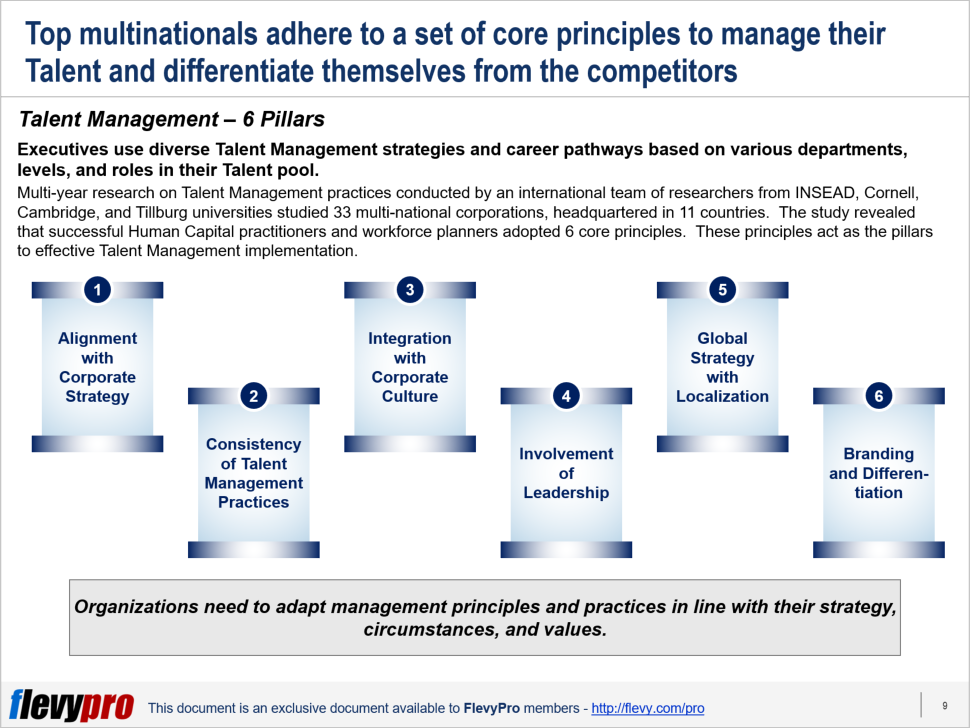Enterprises worldwide face problems selecting, staffing, developing, compensating, motivating, and sustaining their key talent. Building a sustainable Talent pipeline is quite strenuous even for large multinationals.
Replicating best practices from somewhere and applying them alone isn’t sufficient for organizations to build a Talent pipeline and achieve Competitive Advantage. This warrants overcoming arduous challenges associated with this digital age, including:
- Adjusting to varying dynamics in global markets
- Handling the expectations of varied customer segments in different geographies
- Managing the preferences of key Talent
- Acquiring new technologies
- Building novel capabilities
- Achieving Operational Excellence by streamlining operations and improving processes
- Exploring new markets
- Devising strategies to attract, select, develop, assess, and reward top Talent.
Developing Talent Management practices helps the organizations build and retain talented people available in the job market. The term was first used by McKinsey & Company in 1997, and it pertains to planning and managing strategic Human Capital through activities, i.e. attracting, selecting, developing, evaluating, rewarding, and retaining key people.
Executives use diverse Talent Management strategies and career pathways based on various departments, levels, and roles in their Talent pool. Multi-year research on Talent Management practices conducted by an international team of researchers from INSEAD, Cornell, Cambridge, and Tillburg universities studied 33 multi-national corporations, headquartered in 11 countries. The study revealed that successful Human Capital practitioners and workforce planners adopted 6 core principles. These principles act as the 6 pillars to effective Talent Management implementation:
- Alignment with Corporate Strategy
- Consistency of Talent Management Practices
- Integration with Corporate Culture
- Involvement of Leadership
- Global Strategy with Localization
- Branding and Differentiation
Let’s discuss the first 3 pillars in detail, for now.
Alignment with Corporate Strategy
Integrating Talent Management with Corporate Strategy is imperative as the need for future Talent depends on the company’s long-term strategy. Corporate Strategy should guide the identification of Talent required to accomplish organizational goals, since it’s the right Talent that drives the key strategic initiatives rather than strategic planning.
For example, GE’s Talent Management practices have been a great assistance in implementing their strategic initiatives. The organization regards its Talent Management system as their most potent execution tool and has integrated TM processes into their strategic planning process. To sustain its image as an innovation leader, GE targets technical skills as a priority in its annual Strategic Planning sessions. Individual business units lay out their business as well as the Human Capital objectives in GE’s annual strategic planning sessions. Significant time is spent on reviewing its Innovation pipeline, its engineering function’s structure, and Talent requirements. To achieve its vision, GE promotes more engineers in its senior management than its rivals.
Consistency of Talent Management Practices
Talent Management practices must be consistent and synchronous with each other. It is critical not only to invest in advancing the careers of key Talent but also to invest in processes to empower, compensate, and retain them. Human Capital practitioners utilize various tools to ensure consistency of Talent Management practices, including Human Resources satisfaction surveys and qualitative and quantitative data on TM practices implementation.
For example, the success of Siemens is based on consistent monitoring of its systems, processes, and key performance metrics across its subsidiaries. Every element of Human Capital Management is connected, continuously assessed, and linked to rewards. This goes from recruitment of graduates each year, to their orientation, to mentoring and development, to performance evaluation and management, and compensation and benefits.
Integration with Corporate Culture
Corporate culture is regarded as important as vision and mission by renowned global organizations. These companies hold their core values and behavioral standards very high and promote them among their employees through coaching and mentoring. They strive to embed this into their hiring, leadership development, performance management, remuneration, and reward processes / programs. So much so that they consider cultural adaptability a crucial element of their recruitment process—as personality traits and mindsets are hard to develop than technical skills—and evaluate applicants’ behaviors and values rigorously.
For example, among other leading companies, IBM has a special emphasis on values while selecting and promoting people. To ensure consistent values across the board, it organizes regular values jam sessions and employee health index surveys. These sessions encourage open communication and debate on values and organizational culture and their importance among employees.
Interested in learning more about the other pillars of Talent Management, the various approaches to TM? You can download an editable PowerPoint on 6 Pillars of Talent Management here on the Flevy documents marketplace.
Are you a Management Consultant?
You can download this and hundreds of other consulting frameworks and consulting training guides from the FlevyPro library.

Comments